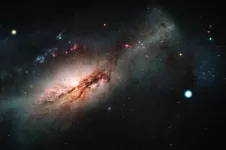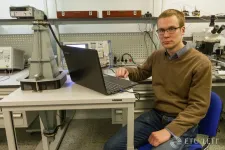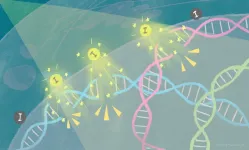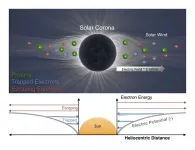A star in a distant galaxy blew up in a powerful explosion, solving an astronomical mystery
Giant explosion in space illuminates thousand-year mystery
2021-07-14
(Press-News.org) Dr. Iair Arcavi, a Tel Aviv University researcher at the Raymond and Beverly Sackler Faculty of Exact Sciences, participated in a study that discovered a new type of stellar explosion - an electron-capture supernova. While they have been theorized for 40 years, real-world examples have been elusive. Such supernovas arise from the explosions of stars 8-9 times the mass of the sun. The discovery also sheds new light on the thousand-year mystery of the supernova from A.D. 1054 that was seen by ancient astronomers, before eventually becoming the Crab Nebula, that we know today.
A supernova is the explosion of a star following a sudden imbalance between two opposing forces that shaped the star throughout its life. Gravity tries to contract every star. Our sun, for example, counter balances this force through nuclear fusion in its core, which produces pressure that opposes the gravitational pull. As long as there is enough nuclear fusion, gravity will not be able to collapse the star. However, eventually, nuclear fusion will stop, just like gas runs out in a car, and the star will collapse. For stars like the sun, the collapsed core is called a white dwarf. This material in white dwarfs is so dense that quantum forces between electrons prevent further collapse.
For stars 10 times more massive than our sun, however, electron quantum forces are not enough to stop the gravitational pull, and the core continues to collapse until it becomes a neutron star or a black hole, accompanied by a giant explosion. In the intermediate mass range, the electrons are squeezed (or more accurately, captured) onto atomic nuclei. This removes the electron quantum forces, and causes the star to collapse and then explode.
Historically, there have been two main supernova types. One is a thermonuclear supernova -- the explosion of a white dwarf star after it gains matter in a binary star system. These white dwarfs are the dense cores of ash that remain after a low-mass star (one up to about 8 times the mass of the sun) reaches the end of its life. Another main supernova type is a core-collapse supernova where a massive star -- one more than about 10 times the mass of the sun -- runs out of nuclear fuel and has its core collapsed, creating a black hole or a neutron star. Theoretical work suggested that electron-capture supernovae would occur on the borderline between these two types of supernovae.
That's the theory that was developed in the 1980's by Ken'ichi Nomoto of the University of Tokyo, and others. Over the decades, theorists have formulated predictions of what to look for in an electron-capture supernova. The stars should lose a lot of mass of particular composition before exploding, and the supernova itself should be relatively weak, have little radioactive fallout, and produce neutron-rich elements.
The new study, published in Nature Astronomy, focuses on the supernova SN2018zd, discovered in 2018 by Japanese amateur astronomer Koihchi Itagaki. Dr. Iair Arcavi, of the astrophysics department at Tel Aviv University, also took part in the study. This supernova, located in the galaxy NGC 2146, has all of the properties expected from an electron-capture supernova, which were not seen in any other supernova. In addition, because the supernova is relatively nearby - only 31 million light years away - the researchers were able to identify the star in pre-explosion archival images taken by the Hubble Space Telescope. Indeed, the star itself also fits the predictions of the type of star that should explode as an electron-capture supernovae, and is unlike stars that were seen to explode as the other types of supernovae.
While some supernovae discovered in the past had a few of the indicators predicted for electron-capture supernovae, only SN2018zd had all six - a progenitor star that fits within the expected mass range, strong pre-supernova mass loss, an unusual chemical composition, a weak explosion, little radioactivity, and neutron-rich material. "We started by asking 'what's this weirdo?'" said Daichi Hiramatsu of the University of California Santa Barbara and Las Cumbres Observatory, who led the study. "Then we examined every aspect of SN 2018zd and realized that all of them can be explained in the electron-capture scenario."
The new discoveries also illuminate some mysteries of one of the most famous supernovae of the past. In A.D. 1054 a supernova happened in our own Milky Way Galaxy, and according to Chinese and Japanese records, it was so bright that it could be seen in the daytime and cast shadows at night. The resulting remnant, the Crab Nebula, has been studied in great detail, and was found to have an unusual composition. It was previously the best candidate for an electron-capture supernova, but this was uncertain partly because the explosion happened nearly a thousand years ago. The new result increases the confidence that the historic 1054 supernova was an electron-capture supernova.
"It's amazing that we can shed light on historical events in the Universe with modern instruments," says Dr. Arcavi. "Today, with robotic telescopes that scan the sky in unprecedented efficiency, we can discover more and more rare events which are critical for understanding the laws of nature, without having to wait 1000 years between one event and the next."
INFORMATION:
Dr. Arcavi is a member of the Global Supernova Project, and makes use of the Las Cumbres telescope network to study rare transient phenomena like supernovae, neutron star mergers, and stars torn apart by black holes.
Link to the original article:
https://www.nature.com/articles/s41550-021-01384-2
[Attachments] See images for this press release:

ELSE PRESS RELEASES FROM THIS DATE:
2021-07-14
A new study co-authored by the UBC Sauder School of Business has found that when senior managers mistreat workers, middle managers often attempt to quietly smooth things over.
Robin Hood was known for stealing from the rich and giving to the poor -- but while he may have lived in Sherwood Forest centuries ago, he would have fit right in as a middle manager in today's business world.
Studies have shown that when employees are mistreated by senior leaders, employees can often get back at them by doing things like gossiping, stealing office supplies or calling in sick when they're well. But according to new research from UBC Sauder, middle managers also get in on the act, and attempt to address workplace injustices by secretly helping out their subordinates ...
2021-07-14
Kamil Gareev, Associate Professor at ETU "LETI," justified the prospects of using magnetotactic bacteria to treat malignant tumors.
LETI researchers identified the main properties of magnetotactic bacteria and described the possibilities of their application in medicine. The results obtained will help create theranostic agents in neurooncology and cardioprotection. The results of the joint study with colleagues from St. Petersburg State University, RAS Institute of Cytology, and RAS Institute of Biotechnology were published as an overview article in the journal Magnetochemistry.
Magnetotactic bacteria (MTB) are distinguished by their ability to synthesize magnetosomes, special cellular organelles in which magnetite biomineralization occurs. Thanks ...
2021-07-14
Autistic people need extra help in going green say researchers behind a new study which argues for a more inclusive environmental agenda.
Climate action movements are gathering extraordinary pace due to international campaigners like Greta Thunberg, whose autism has been well documented. Being autistic has been used to explain and celebrate, but also diminish and denigrate, her activism.
Thunberg, for example, reports that being autistic is a psychological "gift" and "superpower" that underpins her environmental attitudes and behaviours. This has fuelled speculation - in the media and the general public - that autistic ...
2021-07-14
DALLAS, July 14, 2021 -- Heart failure hospitalizations and costs related to methamphetamine use jumped sharply over a decade in California, according to new research published today in Circulation: Cardiovascular Quality and Outcomes, an American Heart Association journal.
"Our study results should bring urgent attention to this insidious yet rapidly growing form of severe heart failure - methamphetamine-related heart failure, which is taking the lives of young people, straining health care resources and threatening to spread like wildfire in California, the West and to the rest of the nation," ...
2021-07-14
PHOENIX, Ariz. -- July 14, 2021 -- The results of a study by an international scientific team co-led by the Translational Genomics Research Institute (TGen), an affiliate of City of Hope, suggest that -- like pouring water atop a wellhead before pumping -- the airway cells of patients with chronic lung diseases are "primed" for infection by the COVID-19 virus, resulting in more severe symptoms, poorer outcomes and a greater likelihood of death.
The study -- published today in Nature Communications -- details the genetic changes caused by chronic lung disease in the molecular makeup of a variety of cells, including the epithelial cells that line the lung and airways. The ...
2021-07-14
The extraordinary ability of animals to rapidly evolve in response to predators has been demonstrated via genetic sequencing of a waterflea population across nearly two decades.
In a new study, published in Nature Communications, scientists at the Universities of Birmingham in the UK, the Katholieke Universiteit Leuven in Belgium, and the Leibniz Institute for Freshwater Ecology and Inland Fisheries (IGB), Berlin, were able to identify more than 300 genes that vary in the genome of the waterflea.
These genes, which account for about about 3 per cent of all sequenced waterflea genes, ...
2021-07-14
Cancer cell death is triggered within three days when X-rays are shone onto tumor tissue containing iodine-carrying nanoparticles. The iodine releases electrons that break the tumor's DNA, leading to cell death. The findings, by scientists at Kyoto University's Institute for Integrated Cell-Material Sciences (iCeMS) and colleagues in Japan and the US, were published in the journal Scientific Reports.
"Exposing a metal to light leads to the release of electrons, a phenomenon called the photoelectric effect. An explanation of this phenomenon by Albert Einstein in 1905 heralded the birth of quantum physics," says iCeMS molecular biologist Fuyuhiko Tamanoi, who led the study. "Our research provides ...
2021-07-14
July 14, 2021 (Toronto) A new study from the World Health Organization's (WHO) International Agency for Research on Cancer (IARC), published in the journal Lancet Oncology, has found an association between alcohol and a substantially higher risk of several forms of cancer, including breast, colon, and oral cancers. Increased risk was evident even among light to moderate drinkers (up to two drinks a day), who represented 1 in 7 of all new cancers in 2020 and more than 100,000 cases worldwide.
In Canada, alcohol use was linked to 7,000 new cases of cancer in 2020, including 24 per cent of breast cancer cases, 20 per cent of colon cancers, 15 per cent of rectal cancers, and 13 per cent of oral and liver cancers.
"All ...
2021-07-14
As the Parker Solar Probe ventures closer to the sun, we are learning new things about our home star.
In a new study, physicists led by the University of Iowa report the first definitive measurements of the sun's electric field, and how the electric field interacts with the solar wind, the fast-flowing current of charged particles that can affect activities on Earth, from satellites to telecommunications.
The physicists calculated the distribution of electrons within the sun's electric field, a feat made possible by the fact that the Parker Solar Probe jetted within 0.1 astronomical units (AU), or a mere 9 million miles, from the sun--closer than any spacecraft has approached. From the electrons' distribution, the physicists ...
2021-07-14
For the first time, scientists have seen stony coral cells engulf dinoflagellates - single-celled, photosynthetic algae that are crucial for keeping coral alive
The researchers used a cell line called IVB5, which contains endoderm-like cells cultured from the stony coral, Acropora tenuis
Around 40% of coral cells incorporated the algae in around 30 minutes and remained healthy for one month
The research is a step towards understanding the partnership between coral and dinoflagellates and could shed light on how coral bleaching occurs
In a world-first, scientists in Japan have observed individual stony coral cells engulfing single-celled, photosynthetic algae.
The microscopic algae, known as dinoflagellates, were ...
LAST 30 PRESS RELEASES:
[Press-News.org] A star in a distant galaxy blew up in a powerful explosion, solving an astronomical mystery
Giant explosion in space illuminates thousand-year mystery




